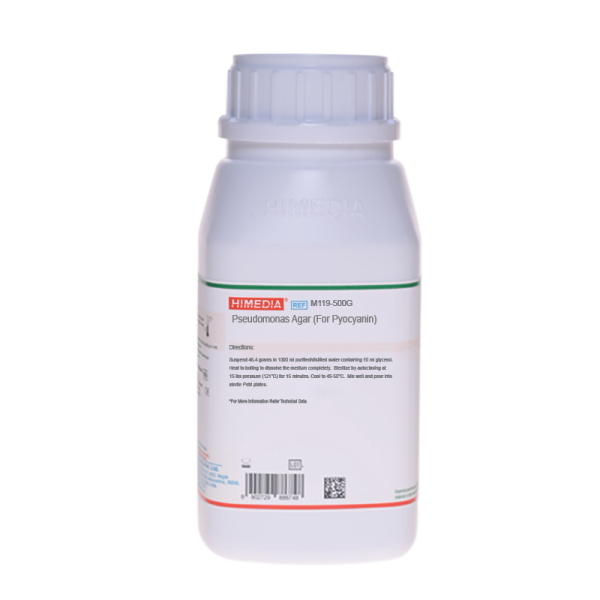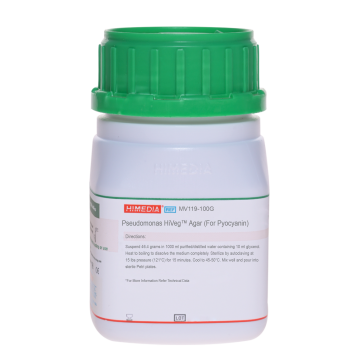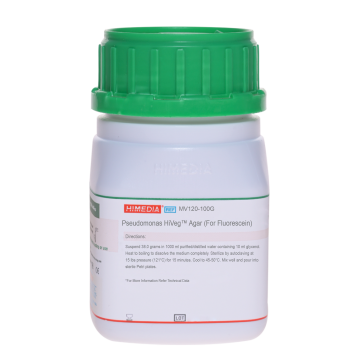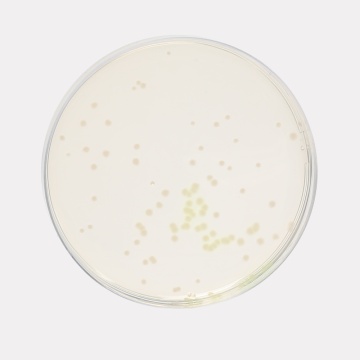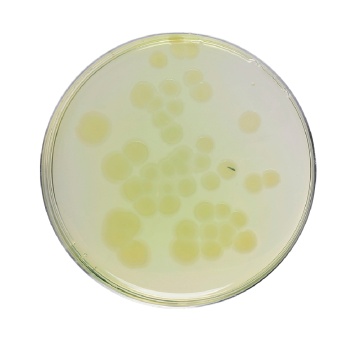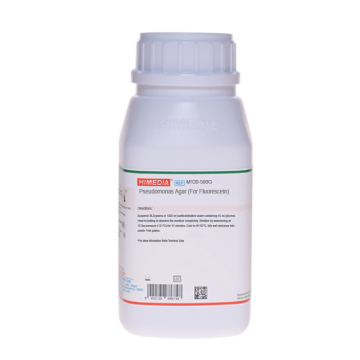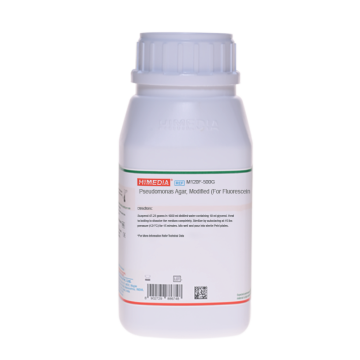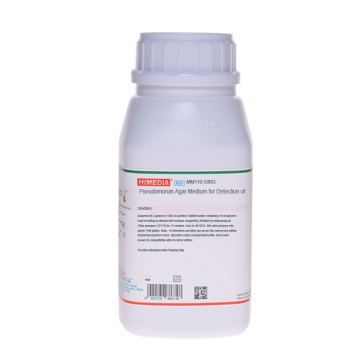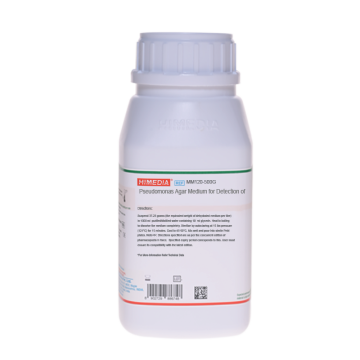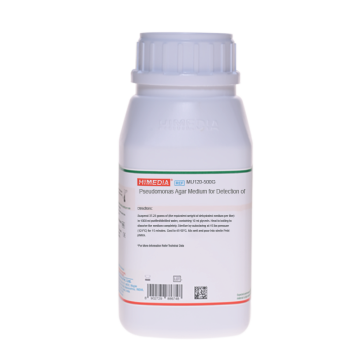 Your enquiry has been submitted
Your enquiry has been submitted
Pseudomonas Agar (For Pyocyanin) (In a accordance with IP 2007)
Intended Use
Recommended for the detection of pyocyanin production by Pseudomonas species.
Composition
| Ingredients | g/L |
|---|---|
| Peptone | 20.000 |
| Potassium sulphate | 10.000 |
| Magnesium chloride | 1.400 |
| Agar | 15.000 |
Final pH (at 25°C): 7.0±0.2
**Formula adjusted, standardized to suit performance parameters
Directions
Suspend 46.4 grams in 1000 ml purified/distilled water containing 10 ml glycerol. Heat to boiling to dissolve the medium completely. Sterilize by autoclaving at 15 lbs pressure (121°C) for 15 minutes. Cool to 45-50°C. Mix well and pour into sterile Petri plates.
Principle And Interpretation
Pseudomonas Agar is based on the formulation described by King et al (1) and as recommended in U.S. Pharmacopoeia (2) for detecting pyocyanin, a water soluble pigment by Pseudomonas species (3). This medium enhances the elaboration of pyocyanin but inhibits the formation of fluorescein pigment. The fluorescein pigment diffuses from the colonies of Pseudomonas into the agar and shows blue colouration. Some Pseudomonas strains produce small amounts of fluorescein resulting in a blue-green colouration.
Peptone supply carbon, nitrogen substances, amino acids, other essential growth nutrients. Potassium sulphate and magnesium chloride, which enhances the pyocyanin production and suppresses the fluorescein production. A pyocyanin-producing Pseudomonas strain will usually also produce fluorescein. It must, therefore, be differentiated from other simple fluorescent Pseudomonads by other means. Temperature can be a determining factor as most other fluorescent strains will not grow at 35°C. Rather, they grow at 25-30°C (3).
Type of specimen
Pharmaceutical samples
Specimen Collection and Handling
For pharmaceutical samples follow appropriate techniques for handling specimens as per established guidelines (2). After use, contaminated materials must be sterilized by autoclaving before discarding.
Warning and Precautions
Read the label before opening the container. Wear protective gloves/protective clothing/eye protection/ face protection. Follow good microbiological lab practices while handling specimens and culture. Standard precautions as per established guidelines should be followed while handling specimens. Safety guidelines may be referred in individual safety data sheets.
Limitations
- This medium is general purpose medium and may not support the growth of fastidious organisms.
Performance and Evaluation
Performance of the medium is expected when used as per the direction on the label within the expiry period when stored at recommended temperature.
Quality Control
Appearance Cream to yellow coloured homogeneous free flowing powder.
Gelling Firm, comparable with 1.5% Agar gel
Colour and Clarity of prepared medium Yellow coloured clear to slightly opalescent gel forms in Petri plates
Reaction Reaction of 4.64% w/v aqueous solution containing 1% v/v glycerol at 25°C.pH:-7.0±0.2
pH 6.80-7.20
Cultural Response Cultural response was observed after an incubation at 35-37°C for 18-48 hours.
| Organism | Inoculum (CFU) | Growth | Observed Lot Recovery value (CFU) | Colour of Medium | |
|---|---|---|---|---|---|
| ^Pseudomonas paraeruginosa ATCC 9027 (00026*) | 50-100 | luxuriant | 25-100 | >=50% | blue-green |
| Pseudomonas aeruginosa ATCC 27853 (00025*) | 50-100 | luxuriant | 25-100 | >=50% | blue-green |
Key: *Corresponding WDCM numbers. ^ Formerly known as Pseudomonas aeruginosa
Storage and Shelf Life
Store between 10-30°C in a tightly closed container and the prepared medium at 20-30°C. Use before expiry date on the label. On opening, product should be properly stored dry, after tightly capping the bottle in order to prevent lump formation due to the hygroscopic nature of the product. Improper storage of the product may lead to lump formation. Store in dry ventilated area protected from extremes of temperature and sources of ignition. Seal the container tightly after use. Product performance is best if used within stated expiry period.
Disposal
User must ensure safe disposal by autoclaving and/or incineration of used or unusable preparations of this product. Follow established laboratory procedures in disposing of infectious materials and material that comes into contact with sample must be decontaminated and disposed of in accordance with current laboratory techniques (4,5).
Reference
- King, Ward and Raney, 1954, J.Lab. and Clin. Med., 44:301
- The United States Pharmacopoeia, 2022, The United States Pharmacopoeial Convention, Rockville, MD.
- MacFaddin J., 1985, Media for Isolation-Cultivation-Identification-Maintenance of Medical Bacteria, Vol. I, Williams and Wilkins, Baltimore.
- Isenberg, H.D. Clinical Microbiology Procedures Handbook 2nd Edition.
- Jorgensen, J.H., Pfaller, M.A., Carroll, K.C., Funke, G., Landry, M.L., Richter, S.S and Warnock., D.W. (2015) Manual of Clinical Microbiology, 11th Edition. Vol. 1.
| Product Name | Pseudomonas Agar (For Pyocyanin) (In a accordance with IP 2007) |
|---|---|
| SKU | M119 |
| Product Type | Regular |
| Physical Form | Powder |
| Origin | Animal |
| Packaging type | HDPE |
| References | 1.King, Ward and Raney, 1954, J.Lab. and Clin. Med., 44:3012.The United States Pharmacopoeia, 2008, The United States Pharmacopoeial Convention, Rockville, MD. 3.MacFaddin J., 1985, Media for Isolation-Cultivation-Identification-Maintenance of Medical Bacteria, Vol. I, Williams andWilkins, Baltimore. |
| Customized Product Available | No |



